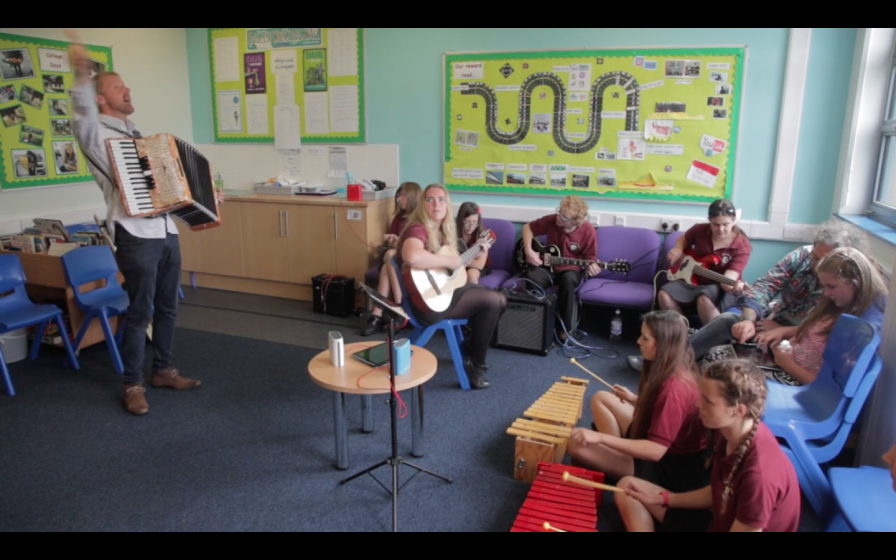Open School Orchestras - creating progression routes for young SEN/D musicians

At the end of our first year of Open School Orchestras (OSO) in Cornwall, we've been thinking about next steps, and how to create progression routes for young SEN/D musicians. We created a short pilot project to explore the idea of inviting mainstream musicians to join the OSO in creative music workshops - integration following on from inclusion work. The short films below show the final performance, and discussion around how to build on the pilot, creating pathways through creative ensembles for those wanting to take their music further, beyond the classroom.
Progression routes nationally for young musicians with ASN (additional support needs) are patchy, at best, with many youngsters not having the chance to even start their musical journey, let alone progress. OpenUp Music have been creating a framework to remedy that, starting with entry-level OSOs in school settings to create those initial opportunities to learn an instrument suited to their needs, and to compose and perform in an ensemble. They've also created a South West Open Youth Orchestra, as a next step for those interested in developing their musical talent - its the UK's first disabled-led regional youth orchestra. And they will be setting up a National Open Youth Orchestra in 2018. This is a great move forward for one coherent strand of inclusive progression routes, a first section of the jigsaw puzzle connecting up. However we see a gap between OSOs in schools, and the regional SWOYO in Bristol. With more OSOs starting in schools and more young musicians emerging, there's a need for progression routes within Cornwall - opportunities at a local and county level.
We also noted that while the first step for a musical inclusion strategy for a county should be to provide opportunities where they are lacking, the next step should be to remove the barriers of isolation, and encourage young people with SEN/D to integrate and make music on equal terms with their mainstream peers, where this is suitable and beneficial. We created a short pilot project to test these two ideas and see how they might work. Patrick Bailey joined us for three short sessions, to lead a creative ensemble combining the OSO with a group of Year 10 GCSE music students. Here's the film of the final performance:
It had quite an impact on the participants and the school leadership. There isn't much regular contact between the mainstream part of Richard Lander School (1,000 students) and the SEN/D unit of 10 students (the ARK), and as one of the students described, it feels like it is "somewhere down the stairs", away from the rest of the school. The music workshops provided a bridge for them to connect. Some comments from the Year 10's on the experience:
- "It gave me tingles when we recorded."
- "I didn't know that it would be so musical!"
- "I wish we could have more time to get to know each other."
And some comments from the school:
- "This is such a wonderful video and clearly a wonderful project. Thank you so much to everyone involved!!!" (Head teacher)
- "This is wonderful, brought a tear to my eye. Thank you to all involved." (School SENDCo)
There's a will within the school to not only support music-making within the ARK unit, but to continue this kind of collaboration with mainstream students next year, and work towards a gig. The films below discuss the benefits of this collaboration, and how we might learn lessons from the pilot in order to build on this work:
Benefits of Open School Orchestra collaboration
Learning lessons from the pilot
And finally there is a short film discussion of how we could build on this pilot, not just within the school, but by setting up creative ensembles outside of school, to start filling the gap we noted between Open School Orchestras, and the regional orchestra in Bristol. Developing these on a local and county level would be a much larger piece of work, but has been very successful at creating inclusive progression routes elsewhere (such as "Animate Orchestra"), not just for young musicians with ASN, but for those in the mainstream too that don't fit into traditional hub-funded ensembles. There are many youngsters who may make music in other ways (e.g., beatboxing, or using music apps), or who need more diversity of musical genres and styles in order to find an appealing pathway for progression.
Creative Ensembles - an inclusive progression route
The beauty of creative ensembles is that they can include a whole variety of different voices in the creative process, even including voices of rebellion and dischord into the final work! Much like this quote from Silmarillion about how the Music of the Ainur brings the world into being, and part of its beauty is that it can include many diverse voices, including the dischord of Melkor:
“And thou, Melkor, shalt see that no theme may be played that hath not its uttermost source in me, nor can any alter the music in my despite. For he that attempteth this shall prove but mine instrument in the devising of things more wonderful, which he himself hath not imagined.” J.R.R.Tolkien
(This project has been run by Cornwall Music Service Trust, with funding from Youth Music, and Cornwall Music Education Hub).
